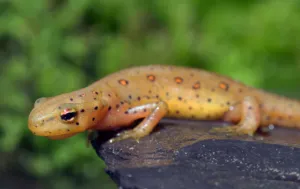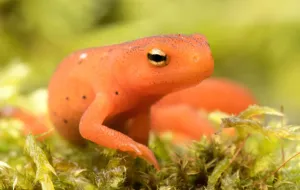
Table of Contents
Scientific Classification
- Kingdom: Animalia
- Phylum: Chordata
- Class: Amphibia
- Order: Caudata
- Family: Salamandridae
- Genus: Notophthalmus
- Species: Notophthalmus viridescens
Quick Overview
The Eastern Newt (Notophthalmus viridescens) is a fascinating amphibian that undergoes distinct life stages, showcasing unique adaptations throughout its development. Found in the eastern parts of North America, including the United States and Canada, the Eastern Newt is well-known for its vibrant coloration and interesting behaviors.
Fast Facts
- Scientific Name: Notophthalmus viridescens
- Lifespan: Up to 15 years in the wild
- Average Size: Adults range from 2 to 5 inches, with efts (juveniles) being smaller
- Diet: Carnivorous, feeding on small invertebrates
- Habitat: Various aquatic habitats, including ponds, lakes, and slow-moving streams
Did you know?
Eastern Newts go through three main life stages: aquatic larva, terrestrial juvenile (eft), and aquatic adult.
Appearance
- Aquatic Larva: During the larval stage, Eastern Newts resemble tadpoles. They have external gills, a laterally flattened tail, and a brown-greenish coloration.
- Terrestrial Juvenile (Eft) or Terrestrial Red Eft: Efts are brightly colored, with orange to red skin and dark spots. They have a more pronounced body shape and are adapted for a terrestrial lifestyle.
- Aquatic Adult: Adult newts return to the water and undergo a transformation, developing a more streamlined appearance. They exhibit a green-brown coloration with a yellow or orange underside.
Size
- Aquatic Larva: Around 0.5 to 1.5 inches
- Terrestrial Juvenile (Eft): Approximately 1.5 to 2.5 inches
- Aquatic Adult: Ranges from 2 to 5 inches

Temperament and Behavior
Eastern Newts are generally calm and docile. During the terrestrial juvenile stage (eft), they are more active and explore the forest floor. Adults are excellent swimmers and may display courtship behaviors during the breeding season.
Fun Fact
The skin of Eastern Newts produces toxins, especially during the eft stage, serving as a defense mechanism against predators.
Habitat and Distribution
Eastern Newts inhabit a variety of aquatic environments, including ponds, lakes, and slow-moving streams. They are found in eastern North America, ranging from the southern parts of Canada down to the Gulf of Mexico.
Care Guide
In captivity, providing a suitable environment with both aquatic and terrestrial areas is essential. Adequate hiding spots, clean water, and a diet of small invertebrates contribute to their well-being.
Diet and Nutrition
Eastern Newts are carnivorous, preying on small invertebrates such as insects, worms, and larvae. Their diet may vary based on their life stage and habitat.
Health and Wellness
Monitoring water quality is crucial for the health of aquatic stages. In captivity, maintaining proper humidity and providing a balanced diet contribute to their overall well-being.
Reproduction
Eastern Newts reproduce through aquatic courtship, with males displaying elaborate mating behaviors. Females lay eggs individually, and the aquatic larvae hatch from these eggs.
Conservation Status
Eastern Newts are not currently considered endangered, but their populations can be affected by habitat loss, pollution, and disease.
Fun Fact
Eastern Newts are excellent climbers and may climb vegetation or rocks near the water’s edge.
Photo Gallery




Related Profiles
Share This Profile
Fascinating Facts About Eastern Newts
- Colorful Transformation: The transition from aquatic larvae to terrestrial eft and then to aquatic adults involves striking color changes.
- Toxic Defense: The eft stage features bright colors as a warning, signaling their toxic skin to potential predators.
- Enchi Ball Python: A Unique and Stunning Morph of Python regius - March 27, 2025
- Emerald Tree Monitor: The Enigmatic Green Guardian of the Rainforest - March 26, 2025
- The Egyptian Cobra (Naja haje): A Fascinating Serpent - March 25, 2025
